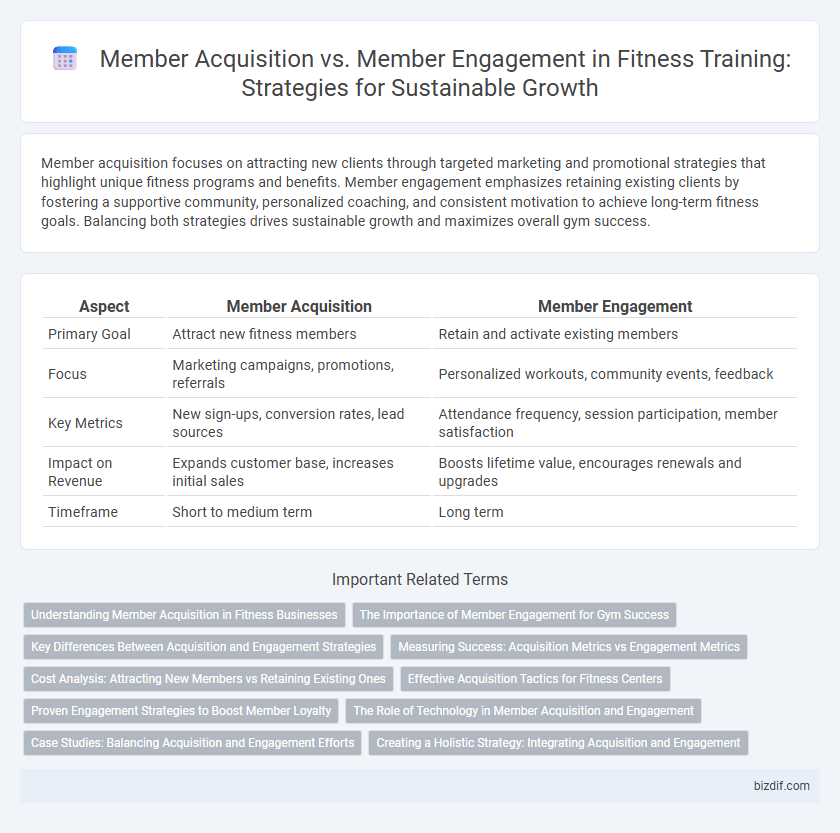Member acquisition focuses on attracting new clients through targeted marketing and promotional strategies that highlight unique fitness programs and benefits. Member engagement emphasizes retaining existing clients by fostering a supportive community, personalized coaching, and consistent motivation to achieve long-term fitness goals. Balancing both strategies drives sustainable growth and maximizes overall gym success.
Table of Comparison
| Aspect | Member Acquisition | Member Engagement |
|---|---|---|
| Primary Goal | Attract new fitness members | Retain and activate existing members |
| Focus | Marketing campaigns, promotions, referrals | Personalized workouts, community events, feedback |
| Key Metrics | New sign-ups, conversion rates, lead sources | Attendance frequency, session participation, member satisfaction |
| Impact on Revenue | Expands customer base, increases initial sales | Boosts lifetime value, encourages renewals and upgrades |
| Timeframe | Short to medium term | Long term |
Understanding Member Acquisition in Fitness Businesses
Member acquisition in fitness businesses involves attracting new clients through targeted marketing strategies, personalized offers, and trial memberships. Effective acquisition requires leveraging digital platforms such as social media advertising, search engine optimization, and influencer partnerships to reach potential members. Understanding demographics, fitness goals, and consumer behavior enhances the ability to convert prospects into committed gym members.
The Importance of Member Engagement for Gym Success
Member engagement directly influences gym retention rates and long-term revenue growth by fostering a strong community and personalized workout experiences. Active participation in classes, regular feedback, and digital app interaction increase member satisfaction and loyalty, reducing churn. Prioritizing engagement strategies enhances the overall gym atmosphere, driving sustained business success beyond initial member acquisition.
Key Differences Between Acquisition and Engagement Strategies
Member acquisition strategies in fitness training prioritize attracting new clients through targeted marketing campaigns, special introductory offers, and trial memberships, aiming to increase the overall customer base. Member engagement focuses on retaining clients by fostering community through personalized workout plans, regular progress tracking, and interactive fitness classes that enhance long-term commitment. The key differences lie in acquisition targeting external prospects to boost numbers, while engagement concentrates on internal satisfaction and loyalty to reduce churn rates.
Measuring Success: Acquisition Metrics vs Engagement Metrics
Measuring success in fitness training involves distinct metrics for member acquisition and engagement, with acquisition focusing on new sign-ups, conversion rates, and cost per acquisition to evaluate recruitment efficiency. Engagement metrics prioritize member retention, session frequency, and active participation rates to assess ongoing commitment and satisfaction. Tracking both acquisition and engagement data provides a comprehensive view of a fitness program's overall effectiveness and growth potential.
Cost Analysis: Attracting New Members vs Retaining Existing Ones
Analyzing cost efficiency in fitness training reveals acquiring new members typically incurs higher expenses due to marketing, onboarding, and promotional offers, averaging 5-7 times more than maintaining existing clients. Retention strategies, including personalized coaching, loyalty programs, and community-building efforts, reduce churn rates and maximize lifetime value, making engagement a more cost-effective investment. Data from industry benchmarks show that increasing member retention by just 5% can boost profits by 25-95%, highlighting the financial advantage of focusing on sustained member engagement over acquisition.
Effective Acquisition Tactics for Fitness Centers
Effective acquisition tactics for fitness centers include targeted social media advertising, referral programs, and limited-time trial offers to attract new members. Utilizing data-driven marketing strategies helps identify high-potential demographics, optimizing outreach efforts. Leveraging local partnerships and community events boosts visibility and drives initial member sign-ups.
Proven Engagement Strategies to Boost Member Loyalty
Proven engagement strategies such as personalized workout plans, regular progress tracking, and interactive group classes significantly enhance member loyalty in fitness training. Leveraging mobile apps with push notifications and social challenges increases consistent member participation and community building. Focusing on engagement rather than solely on member acquisition results in higher retention rates and long-term revenue growth for fitness centers.
The Role of Technology in Member Acquisition and Engagement
Technology plays a pivotal role in fitness training by enhancing member acquisition through targeted digital marketing campaigns, user-friendly mobile apps, and seamless online sign-up processes. For member engagement, wearable devices and personalized fitness tracking software provide real-time feedback and motivation, fostering consistent participation. Integration of AI-driven recommendations and virtual classes further boosts retention by delivering customized workout experiences tailored to individual goals.
Case Studies: Balancing Acquisition and Engagement Efforts
Case studies in fitness training reveal that balancing member acquisition and engagement efforts drives sustainable growth and retention. Successful gyms implement targeted marketing campaigns alongside personalized engagement strategies, such as customized workout plans and community-building events, to enhance member loyalty. Data shows that facilities investing equally in onboarding and continuous interaction achieve higher lifetime value and lower churn rates.
Creating a Holistic Strategy: Integrating Acquisition and Engagement
Creating a holistic strategy in fitness training requires integrating member acquisition and member engagement to ensure sustainable growth. Combining targeted marketing campaigns with personalized workout plans and regular communication fosters both initial sign-ups and long-term retention. Leveraging data analytics to track member behavior enhances the ability to tailor experiences that convert prospects into loyal, active participants.
Member Acquisition vs Member Engagement Infographic

 bizdif.com
bizdif.com